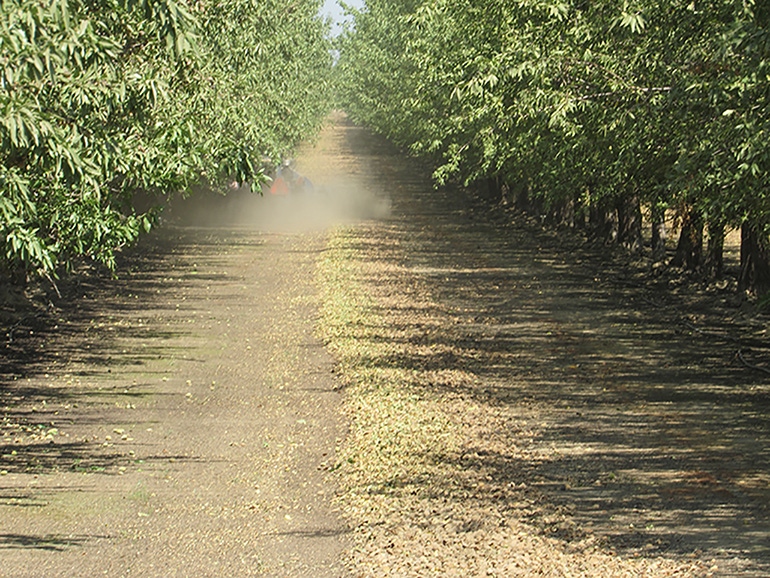
Despite a late spring season, almond hull-split has begun in parts of the San Joaquin Valley, a process that will rapidly begin to affect all almond orchards of the Golden State in the days ahead. Generally, hull-split for walnuts will happen much later, at least 30-60 days later depending on orchard location and other factors.
Hull-split is a critical time for nut producers to begin monitoring the risks of navel orangeworm infestations as well as monitoring for other types of pests and diseases that pose a serious risk to tree nut production.
This year has so far varied from the norm, largely because of cooler temperatures in early spring and a delayed bloom season for many orchards. While variety is the primary driving factor in hull-split timing, weather and tree stress are also contributing factors.
Regardless, hull-split is a critical time for California nut growers. Staying alert and cognizant of the risks are necessary. The shorter the duration of hull-split, the better chance of avoiding unwanted risks. This makes orchard management practices a critical component for the grower and one that cannot be overlooked.
Production expectations down
The latest USDA numbers indicate 2019’s nut production totals will fall below earlier expectations, especially for almonds, a critical factor for nut growers facing increasing tariffs on exports and a year of other challenges including weather and the influence of other natural disasters.
Before we look at other timely mid-summer orchard management practices, it seems important to address the latest production estimates for the year and how they might play into your marketing plan.
Weather-related disruptions are apparently contributing to an expected decline in California almond production this year according to Kern County orchard advisors. According to state numbers from the California Department of Agriculture, Golden State growers will turn out about 2.2 billion pounds of almonds, an estimated 3.5 percent reduction over 2018 production totals.
Not all growers agree with the assessment; some are hoping the final production numbers will be slightly higher than the latest USDA estimates. Nonetheless, any reduction in total production is expected to impact the California almond industry to one degree or another.
Focus on nut quality
As a result of the possibility of lower production numbers, University of California Cooperative Extension (UCCE) advisors are suggesting growers should focus on nut quality to maximize the value of their crop, and this is where good orchard management practices can help to offset fewer nut numbers.
“In the month of July, I would say my major focus would be monitoring and managing irrigation timing. I prefer using the pressure chamber and using a plant-based approach; to monitor irrigation timing when the trees are two or three bars below the fully watered baseline,” UCCE advisor Luke Milliron reports.
Monitoring for pests would be another major concern for July walnut orchard management in the Sacramento Valley region, he said.
“Growers should continue to monitor for mites and checking traps and monitoring for codling moth and naval orangeworm control,” he added.
Milliron says he doesn’t know if growers did a good job in timely spraying in spite of a wet spring, but he has not been seeing a lot of disease pressure in orchards so far. But he has seen what he termed some concern for what he says are environmental or physiological problems as a result of wet conditions in the spring.
“I have seen a lot of drop in the Howard walnut variety because of a big ramp up of heat in early June following the cool, wet spring in my part of the state. Even back in May we observed mesophyll collapse in walnut leaves (necrosis or browning between the veins of the leaf). Even though mesophyll collapse does not cause economic damage it also relates back to dramatic changes in spring temperatures,” he noted.
Milliron participated in a listing of other important walnut orchard management tasks for mid-summer co-authored by UCCE’s Emily Symmes and Dani Lightle.
Other management concerns for July include continuing monitoring for husk fly and task samples to determine nitrogen, potassium and zinc levels in the Sacramento Valley.
Concerning nut quality, Elizabeth Fichtner, UCCE Farm Advisor, Tulare County; Carlos Crisosto, Cooperative Extension Specialist, Postharvest Physiology; and Bruce Lampinen, Cooperative Extension Specialist, Plant Sciences, recommended in the same issue of the Sacramento Valley Walnut News that improving nut quality may be the determining factor influencing orchard profitability this year. The same would be true for almonds, especially considering lower expected production numbers this year.
To improve quality, irrigation timing is critical. Increasing kernel size and improving kernel color in walnuts are the two key components of quality. Nuts with a larger kernel size and lighter color pellicle (outer coating on the kernel) garner the highest prices in the market.
“You’ll get the biggest bang for your buck if your cultivars respond well to ethephon application. Tulare is extremely sensitive to ethephon, while Howard and Vina respond well,” the advisors note.
Almond orchard management considerations should also include Regulated Deficit Irrigation (RDI) factors. RDI promotes earlier, more even hull-split and reduces hull rot. At the onset of hull-split, shorten normal irrigation time by 50 percent for the first couple of weeks in July says former Almond Doctor David Doll in a 2018 article. Then catch up the last two weeks of the month before harvest by providing full irrigation. Moderate water stress can be achieved and monitored by keeping mid-day stem water potential between -14 to -18 bars using a pressure chamber.
Navel orangeworm management and mite management also are key July issues in almonds as well as nutrient management.
In other news
According to the California Department of Water Resources, most of California’s reservoirs are well above average thanks to spring rains. Also, this year’s snowpack at the beginning of June measured nearly 200 percent above normal average.
America First?
Finally this week, few would argue America’s major concerns should come first when establishing good agricultural policies. But many agricultural economists are saying when it comes to damaging trade conflicts, while American interests remain paramount to sound policy decisions, there is something that needs to be said about going too far too fast, such as with the current state of escalating trade troubles with foreign buyers. India has now joined China, Mexico, Canada and Europe in the boycotting tariff arena against the USA.
The resulting hardships created for U.S. agriculture is far from being remedied by tariff mitigation measures that serve as a small dent in current and possibly long-lasting troubles for U.S. traders.
As time moves forward with few hints of a lasting solution, more and more farm groups are encouraging producers to let their concerns be known. Regardless where you stand on the political spectrum, good national trade policy is far too critical to ignore, just a foot note as the upcoming political year seems to be off to an early start. Now may be a good time to have your voice heard, either pro or con.
For more news on tree nuts as reported by growers and farm advisors, subscribe to the Tree Nut Farm Press e-newsletter.
About the Author(s)
You May Also Like






